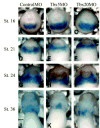Tbx5 and Tbx20 act synergistically to control vertebrate heart morphogenesis
- PMID: 15634698
- PMCID: PMC1635804
- DOI: 10.1242/dev.01596
Tbx5 and Tbx20 act synergistically to control vertebrate heart morphogenesis
Abstract
Members of the T-box family of proteins play a fundamental role in patterning the developing vertebrate heart; however, the precise cellular requirements for any one family member and the mechanism by which individual T-box genes function remains largely unknown. In this study, we have investigated the cellular and molecular relationship between two T-box genes, Tbx5 and Tbx20. We demonstrate that blocking Tbx5 or Tbx20 produces phenotypes that display a high degree of similarity, as judged by overall gross morphology, molecular marker analysis and cardiac physiology, implying that the two genes are required for and have non-redundant functions in early heart development. In addition, we demonstrate that although co-expressed, Tbx5 and Tbx20 are not dependent on the expression of one another, but rather have a synergistic role during early heart development. Consistent with this proposal, we show that TBX5 and TBX20 can physically interact and map the interaction domains, and we show a cellular interaction for the two proteins in cardiac development, thus providing the first evidence for direct interaction between members of the T-box gene family.
Figures









Similar articles
-
Murine T-box transcription factor Tbx20 acts as a repressor during heart development, and is essential for adult heart integrity, function and adaptation.Development. 2005 May;132(10):2451-62. doi: 10.1242/dev.01799. Epub 2005 Apr 20. Development. 2005. PMID: 15843414
-
The BMP pathway acts to directly regulate Tbx20 in the developing heart.Development. 2010 Jun;137(11):1919-29. doi: 10.1242/dev.043588. Development. 2010. PMID: 20460370 Free PMC article.
-
Differential expression and function of Tbx5 and Tbx20 in cardiac development.J Biol Chem. 2004 Apr 30;279(18):19026-34. doi: 10.1074/jbc.M314041200. Epub 2004 Feb 20. J Biol Chem. 2004. PMID: 14978031
-
Mechanisms of T-box gene function in the developing heart.Cardiovasc Res. 2011 Jul 15;91(2):212-22. doi: 10.1093/cvr/cvr112. Epub 2011 Apr 14. Cardiovasc Res. 2011. PMID: 21498422 Review.
-
Tbx20, Smads, and the atrioventricular canal.Trends Cardiovasc Med. 2010 May;20(4):109-14. doi: 10.1016/j.tcm.2010.09.004. Trends Cardiovasc Med. 2010. PMID: 21335279 Review.
Cited by
-
Genetic and functional variants of the TBX20 gene promoter in dilated cardiomyopathy.Mol Genet Genomic Med. 2024 Jan;12(1):e2355. doi: 10.1002/mgg3.2355. Mol Genet Genomic Med. 2024. PMID: 38284443 Free PMC article.
-
Discovery of TBX20 as a Novel Gene Underlying Atrial Fibrillation.Biology (Basel). 2023 Aug 30;12(9):1186. doi: 10.3390/biology12091186. Biology (Basel). 2023. PMID: 37759586 Free PMC article.
-
The Tbx20-TLE interaction is essential for the maintenance of the second heart field.Development. 2023 Nov 1;150(21):dev201677. doi: 10.1242/dev.201677. Epub 2023 Oct 30. Development. 2023. PMID: 37756602 Free PMC article.
-
Epigenetic Evaluation of the TBX20 Gene and Environmental Risk Factors in Mexican Paediatric Patients with Congenital Septal Defects.Cells. 2023 Feb 11;12(4):586. doi: 10.3390/cells12040586. Cells. 2023. PMID: 36831251 Free PMC article.
-
Use of Frogs as a Model to Study the Etiology of HLHS.J Cardiovasc Dev Dis. 2023 Jan 29;10(2):51. doi: 10.3390/jcdd10020051. J Cardiovasc Dev Dis. 2023. PMID: 36826547 Free PMC article.
References
-
- Baldini A. DiGeorge syndrome: an update. Curr Opin Cardiol. 2004;19:201–204. - PubMed
-
- Basson CT, Bachinsky DR, Lin RC, Levi T, Elkins JA, Soults J, Grayzel D, Kroumpouzou E, Traill TA, Leblanc Straceski J, et al. Mutations in human cause limb and cardiac malformation in Holt-Oram syndrome. Nat Genet. 1997;15:30–35. - PubMed
-
- Benson DW, Basson CT, MacRae CA. New understandings in the genetics of congenital heart disease. Curr Opin Pediatr. 1996;8:505–511. - PubMed
Publication types
MeSH terms
Substances
Grants and funding
LinkOut - more resources
Full Text Sources
Other Literature Sources

